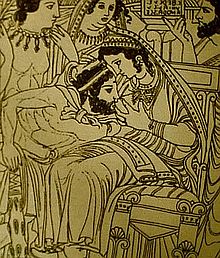
Back Hercle Catalan Hercle Spanish Hercle French Hercle Italian Herkle Lithuanian Hercle SIMPLE Herakle Slovak Херкле Serbian Hercle Turkish
| Hercle | |
|---|---|
 Drawing of a scene on an Etruscan mirror in which Uni suckles the adult Hercle before he ascends to immortality | |
| Genealogy | |
| Parents | Tinia and a mortal woman (raised and adopted by Uni) |
| Siblings | Menrva (half-sister) |
| Equivalents | |
| Canaanite | Melqart[1] |
| Greek | Heracles |
| Roman | Hercules |
| Egyptian | Heryshaf |
| Germanic | Hercules Magusanus |
In Etruscan religion, Hercle (also Heracle or Hercl), the son of Tinia and Uni, was a version of the Greek Heracles, depicted as a muscular figure often carrying a club and wearing a lionskin. He is a popular subject in Etruscan art, particularly bronze mirrors, which show him engaged in adventures not known from the Greek myths of Heracles or the Roman and later classical myths of Hercules.[2]
In the Etruscan tradition, Uni (Roman Juno) grants Hercle access to a life among the immortals by offering her breast milk to him.[3][4][5] Hercle was the first man elevated to a godhood through his deeds and Etruscan aristocrats tried to identify with this ascension, as reflected in artwork and literature.
Hercle differed in many aspects from the Greek Heracles.[5] He seems to have enjoyed a special status in Italy in general.[5] In art, he is shown to be a defender of an unknown goddess against creatures on the other side of a human border, showing his status as a Liminal deity.[5] In Etruria, he was also associated with running water.[5] He was also the master of animals, the protector of flocks and herds, and of herdsmen.[5]
- ^ "Melqart | Encyclopedia.com". www.encyclopedia.com. Retrieved 2020-05-20.
- ^ Nancy Thomson de Grummond, Etruscan Myth, Sacred History, and Legend (University of Pennsylvania Museum of Archaeology and Anthropology, 2006), pp. 12–13.
- ^ De Grummond, Etruscan Myth, pp. 83–84.
- ^ The Religion of the Etruscans. University of Texas Press. 2006. ISBN 0-292-70687-1.
- ^ a b c d e f The Etruscan World. Routledge. 2013. ISBN 978-0-415-67308-2.